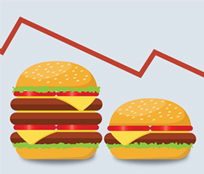The Consumer Price Index (CPI) showed a 0.2% gain in September, or 2.2% annualized. The closely watched core CPI rose a bit more briskly, up 0.3%, or at a 3.9% annualized rate. With Federal Reserve (Fed) Chair Powell having emphasized technical eccentricities in the shelter pricing data, we have been tracking a measure of core inflation that excludes shelter. That measure rose 0.4%, or at a 4.8% annualized rate.
The core inflation readings are higher than what we had been seeing in recent months. That may be due to the effects of both the longshoremen’s strike and Hurricane Helene. Core goods prices rose 0.2%, or 2.1% annualized, after hovering in negative territory for 13 of the preceding 14 months. Car prices rose slightly, after trending lower in preceding months, and prices for food, apparel and personal care products (toiletries) all bounced.

Similarly, on the services side, prices for utilities, medical care, car leasing and airfares all increased at substantially faster rates than in preceding months. In sectors other than those identified here, goods prices continued to decline as we had been seeing and services prices continued moderate. All things considered, September inflation was only modestly higher than in previous months, the gains were focused in a few sectors and strike/hurricane effects could be a big part of the story.
Interestingly, a bright spot of the September inflation picture was shelter costs. Both tenants’ rents and homeowners’ equivalent rents moderated in September, with tenants’ rents up 0.3% (3.4% annualized) and homeowners’ rents up 0.3% (4.1% annualized). After holding at 5% annualized increases for most of the past year, rents slowed in July, bounced back in August, and then slowed again in September. Maybe the September softness also reflects hurricane effects.
Our reference to “homeowners’ rents” may have struck you as odd, but this is standard fare for the inflation data. Homeowners’ costs are reckoned as the implicit value of shelter—or rents—that homeowners derive from residing in their abodes. In effect, homeowners rent to themselves, so how much do they charge themselves? The government shifted to this metric in the mid-1980s, after having previously defined homeowners’ costs based on home sales prices and mortgage interest rates.
The homeowners’ rent metric makes economic sense. The problem is how to measure it. Do homeowners really know how much value they derive from their residence? We could go on, but you get the picture. Homeowners’ rents account for 26.8% of the CPI and 33.6% of the core CPI. While home sales prices have generally been flat for the last two years, homeowner costs reported within the CPI had continued to rise at a 5% annualized rate until posting some moderation over the last three months.
It will be interesting to see if price increases in general subside as the hurricane season passes, and whether shelter prices continue to moderate. We said last week that the stronger September job gains might give the Fed pause in its rate-cutting deliberations. The same could be said of today’s inflation news, though strike/hurricane effects should temper such concerns.

